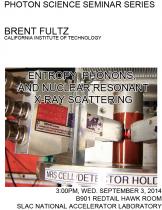Speaker: Brent Fultz, California Institute of Technology
Program Description
Atom vibrations are usually the main source of entropy in materials [1]. This talk will explain where vibrational entropy comes from, why it is important, and how it can be understood by measuring phonon spectra.
Nuclear resonant inelastic x-ray scattering uses nuclear excitations from specific isotopes such as 57Fe. We measured phonon spectra from bcc iron at all temperatures where it is stable [2]. The change of the phonon spectra with temperature is not consistent with anharmonic effects of phonon-phonon interactions, but follows the magnetic entropy of the alloy through the Curie transition. A large magnon-phonon interaction alters the thermodynamic stability of bcc iron by 35 meV/atom at 1150 K.
[1] B. Fultz, Phase Transitions in Materials (Cambridge University Press, 2014). Chapters 2, 7, 24.
[2] L. Mauger, M.S. Lucas, J.A. Muñoz, S.J. Tracy, M. Kresch, Yuming Xiao, Paul Chow, and B. Fultz, "Nonharmonic Phonons in alpha-Iron at High Temperatures," Physical Review B 90, 064303 (2014).





